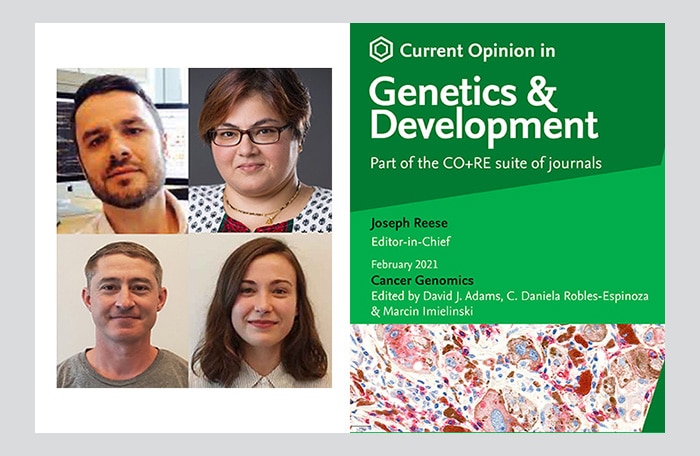Marcin Imielinski, MD, PhD, Core Faculty Member at the New York Genome Center (NYGC), is co-editor of a special “Cancer Genomics” issue of Current Opinion in Genetics & Development published last month. The issue includes a review paper by NYGC scientists on spatially resolved transcriptomics (SRT), selected by Nature Methods as “Method of the Year” for 2020.

Marcin Imielinski, MD, PhD, co-editor of the special issue, is also co-author on several other cancer genomics studies released to date this year.
In their editorial overview entitled “The most difficult of years in cancer research,” Dr. Imielinski, who holds a joint appointment at Weill Cornell Medicine, and co-editors David J. Adams, PhD, and Daniela Robles-Espinoza, PhD, of the Wellcome Trust Sanger Institute, provide a dramatic tee-up to detailing the scope of this special issue:
“As we write this editorial overview, weary from a year of working from home, self-isolation and the turmoil that the COVID-19 pandemic has brought, we reflect on the challenges and promise of cancer research looking forward, mindful that the pandemic has changed this future in many ways, whilst also highlighting disparities in healthcare systems and access to cancer care.” Noting that they “wanted to provide a platform for researchers in low-and-middle income countries to tell their stories,” the editors include reports on cancer genomics in Sub-Saharan Africa and in Latin America in this special issue. Other topics covered in the issue’s collection of papers include therapeutic advances, insights from next-generation sequencing, and reviews of new technologies.

Included in this last category is Spatially resolved transcriptomics and its applications in cancer, a review paper with the NYGC’s Hemali Phatnani, PhD, Director, Center for Genomics of Neurodegenerative Disease (CGND), Silas Maniatis, PhD, a CGND scientist now serving as Lead Scientist, Spatial Genomics & Engineering in NYGC’s Technology Innovation Lab, and CGND graduate student Joana Petrescu as senior author, first author, and co-author, respectively. In the paper, the team provides a survey of currently available SRT technologies for use in studies of tumor samples. Their study provides an assessment and comparison of three major categories of SRT based upon how each technology encodes spatial information, summarizing their particular application to cancer research.
The team’s paper comes on the heels of Nature Methods’ announcement, on January 6, crowning SRT as its prestigious “Method of the Year” for 2020. The CGND team has been longtime deployers of SRT in research, most notably in the development of a multidimensional ALS gene expression atlas in a global collaborative study published in Science in 2019. Drs. Phatnani and Maniatis are senior author and co-first author, respectively of the Science study.
In the Current Opinion paper, the team, already well-versed in SRT’s value in advancing understanding of neurodegenerative disease, points to the particular promise of applying SRT to cancer research. “Understanding the spatial heterogeneity of tumors is clinically consequential, especially in instances where limited physical sampling of tumors is used to guide treatment,” they note.
The researchers also stress that SRT’s expanded use will be aided through multimodal integration with other genomic technologies, a key mission of the multi-institutional Center for Integrated Cellular Analysis established at the NYGC last year. In their review paper, the team cites tools including Seurat, developed by the Satija Lab at NYGC and NYU, and CITE-seq, developed by the NYGC Technology Innovation Lab in collaboration with the Satija Lab, as examples in these objectives. “As the catalog of published SRT and scRNAseq datasets expands, including through large scale tissue atlassing efforts, such study designs will continue to be commonly employed. Further, accessible computational methods such as Seurat enable alignment of data between experiments and across SRT and single-cell technology platforms, including from multimodal methods such as CITE-seq,” they note.
